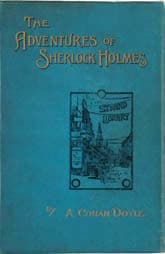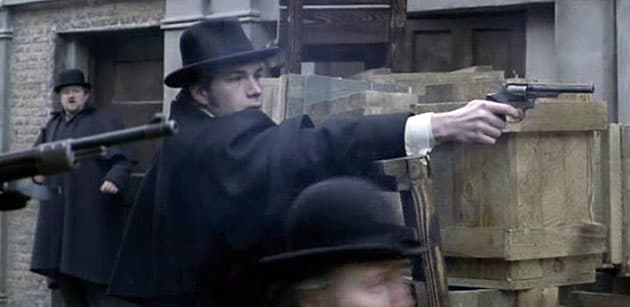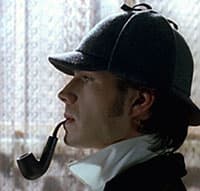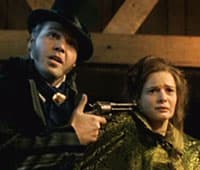The Adventures of Sherlock Holmes
Critique • Quotes • Text • Sherlock Holmes at the movies
 First edition
First editionFirst publication
1892
Literature form
Story collection
Genres
Crime, mystery
Writing language
English
Author's country
England
Length
Twelve stories, approx. 94,000 words

Young Sherlock Holmes joins a shootout in the 2002 made-for-TV movie Sherlock: Case of Evil.
Callow Sherlock
Sherlock: Case of Evil (2002): Television movie, 90 minutes; director Graham Theakston; writer Piers Ashworth; featuring James D'Arcy, Roger Morlidge, Vincent D'Onofrio, Gabrielle Anwar, Richard E. Grant, Nicholas Gecks
Here's an odd one you may find floating around obscure streaming services.
The made-for-television Sherlock: Case of Evil has all the signs of being a pilot for an intended British series. It takes pains to bring Holmes and Watson together—the duo's origin story starting further in the past than even Arthur Conan Doyle's original A Study in Scarlet would have it. And it introduces the other Sherlockian characters—Lestrade, Mycroft, Moriarty—who may recur in future episodes. A romantic interest, who could lead Holmes down a different path from becoming the cold calculating machine we know he becomes, is killed off in good episodic television fashion.
Moreover, the demise of Holmes's great enemy at the end is only implied, never shown explicitly, leaving open the possibility of many more encounters in further adventures.
There wouldn't be any further adventures though. Not in this would-be franchise. Which may be due in part to the fans' outcry over the changes made to their beloved sleuth.
Holmes is sexed up for this rendition—though mildly so, compared to some of the outrages in productions to come a bit later in the twenty-first century. James D'Arcy's consulting detective is a blandly handsome fellow in his twenties and prone to bedding blandly attractive young women. An action hero really, he's also not afraid to engage in fisticuffs, sword fights and shootouts to catch criminals, quite unlike the cerebral detective we've come to know elsewhere.
His inexperience is also apparent, as he makes several mistakes in his detecting and indulges in vain boasts to the press of his claimed successes in solving crimes. Again unlike the Sherlock we're more familiar with.
But to be fair, Sherlock: Case of Evil is a sort of a prequel to the later adventures of Sherlock Holmes. He has not quite formed yet. Watson, who is conducting autopsies for the police when he meets Holmes, has some fun with helping shape the soon-to-be-storied detective.
One clever scene is when he castigates the young Holmes for smoking cigarettes and drinking. Tobacco is a known dangerous drug and will no doubt be made illegal, unlike the benevolent cocaine and opium, Watson advises.
In the movie's last scene, he makes Sherlock the present of a pipe while a relative sends him a deer-stalker cap, leading to a concluding shot of the famous profile—presumably showing the detective as he would appear in future cases.
One earlier scene may also reverberate for Holmesians. Sherlock and his brother Mycroft—played by the deliciously eccentric British actor Richard E. Grant—put on a show of deduction for Watson, spinning stories about people passing in the street outside their window. It's a scene that's been in several past Sherlock Holmes productions, but still comes off well here.
But for my money, the most exciting character is the villain of the piece, Moriarty, played by the deliciously eccentric American actor Vincent D'Onofrio.
He was criticized for having an erratic British accent but something about the performer's physicality or theatricality makes him charismatic—in an offbeat evil kind of way, of course.
I just wish he had more to do in this film, something fiendishly clever, instead of being ultimately reduced to the role of a thug. I mean, taking a damsel hostage at gunpoint is unworthy of Moriarty's dastardly machinations.
It would have been interesting to watch how these characters would be developed in a series—to see whether the show would settle into the less-action-more-mystery tradition of Sherlock Holmes, so beloved by fans, or would continue to rewrite the saga. Too bad it never happened. But, not to worry, a couple of series taking Holmes, Watson, friends and enemies in startling new directions are just around the corner in the coming decades.
— Eric
Critique • Quotes • Text • Sherlock Holmes at the movies
1922, 1929–1933, 1931–1937, 1939–1946, 1954–1955, 1959–1984, 1962–1992, 1965, 1970, 1975–1988, 1976, 1979, 1982, 1984–1994, 2000–2002, 2002, 2002b, 2009–2011, 2010–2017, 2012–2019, 2015



